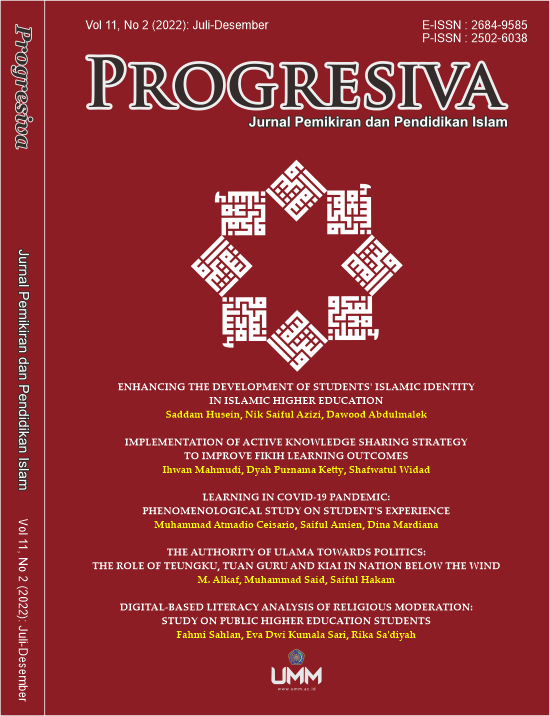Enhancing the Development of Students’ Islamic Identity in Islamic Higher Education
DOI:
https://doi.org/10.22219/progresiva.v11i02.23094Keywords:
Globalization, Islamic Identity, LPPI, Al-Islam and Kemuhammadiyahan, Islamic Higher Education.Abstract
The present study explores the role of the Institute for Islamic Studies and Practice (LPPI), Universitas Muhammadiyah Yogyakarta (UMY) in developing the students' Islamic identity. The study employed a qualitative case study design to capture the real-life context of LPPI UMY in playing its role. Through purposive sampling, the head of LPPI was selected as an informant in the study, considering his role and experiences leading this institution for about ten years. A depth semi-structured interview was conducted for data collection. The data were analyzed through thematic analysis to emphasize pinpointing, examining, and recording patterns (or “themes”) from the verbatim transcribed data. The findings revealed that LPPI UMY, as an institution mandated by the university to manage and develop Al-Islam dan Kemuhammadiyahan (AIK) for the entire academic community in UMY, plays its role in developing the Students' Islamic identity through two significant programs: Learning and Guidance Programs. Learning programs are conducted as courses inside the faculty's curricula and consist of four courses, AIK 1, 2, 3, and AIK 4. On the other hand, Guidance programs are conducted as extracurricular and formulated in the form of the scheme of character building through some stages of Islamic activities, as well as supported by other programs such as Ramadhan activities.
Downloads
References
Abbas, Mohd,. et all. (2021). Globalization and the New Realities in the Muslim World. Project: London Churchill College. Journal of Contemporary Development & Management Studies. Vol. 9. https://bit.ly/3HIvunF
Achmad, Abdul Kholid. (2021). Dosen Sebagai Driving Forceinternalisasi Nilai-Nilai Al-Islam dan Kemuhammadiyahanpada Mahasiswa Universitas Muhammadiyah Gresik. Ta’lim: Jurnal Pendidikan Islam. Retrieved from: https://bit.ly/3ePsb59
Akarowhe, Kingsley. (2018). Effects and Remedies to Cultural Shock on the Adolescent Students. Biomedical Journal of Scientific & Technical Research. Vol 7, No. 5. (BJSTR). DOI: 10.26717/BJSTR.2018.07.001569
Ali, Saudullah. (2016). Preserving Cultural Identity through Islamization of Education: Implications for Muslim Higher Education Institutions. PhD dissertation, IIUM.
Azmi, Mohd Nazri Latiff, et al. (2021). Islamic Self-Identity Formation Through Language Learning: A Study of Religious Secondary School Students in Malaysia. English Language and Literature Studies, Vol. 11, No. 1. DOI: 10.5539/ells.v11n1p38
Bouyahya, Driss. (2018). Islamism and Identity Crisis. Conference: 6th International Conference on Modern Approach in Humanities. DOI: 10.33422/6mah.2018.11.31, https://bit.ly/3r1PWcr
Braun, V. & Clarke, V. (2006). Using thematic analysis in psychology. Qualitative Research in Psychology. University of the West of England: New Zealand. Retrieved from: https://bit.ly/2CYv0gu
Brzozowski, W. (2018). Is Islam incompatible with European identity?. Conference: Religious pluralism and European integration: new challenges. University of Milan-Bicocca School of Law. Retrieved from: https://bit.ly/3mM40pP
Case, S. S. and Chavez E. (2017b). Measuring Religious Identity: Developing a Scale of Religious Identity Salience. Academic Track – Transformative Teaching International Association of Management, Spirituality and Religion Fayetteville, Arkansas. https://bit.ly/3f49aZm
Chen, Bateer and Humaira Tabassum. (2019). How Muslim Students Keep Their Identity on Non- Muslim University Campus. Sci.Int.(Lahore), 31(1)B,127-133. https://bit.ly/2XxwxoS
Crossman, Ashley and updated by Nicki Lisa Cole (March 18, 2017). Understanding Purposive Sampling. An Overview of the Method and Its Applications. Thought Co. Retrieved from: https://bit.ly/2HlQzoA
Demirci, C. (2017). The Effect of Active Learning Approach on Attitudes of 7th Grade Students. International Journal of Instruction, 10(4), 129-144. Retrieved from: https://bit.ly/3SEWbi7
Duderija, Adis. (2008). Factors Determining Religious Identity Construction among Western-born1 Muslims: Towards a Theoretical Framework. Journal of Muslim Minority Affairs, Vol. 28, No. 3. DOI: 10.1080/13602000802548003, Retrieved from: https://bit.ly/3LhU5mn
Elsaie, Adel. (n.d). Islamic Identity. Usislam.org. https://bit.ly/3mOEYUM
Erikson, E. (1968). Identity, Youth and Crisis. New York: Norton.
Fatin, Rafa S. (2020). Perilaku Menyimpang Mahasiswa Berprestasi (Studi Kasus 3 Mahasiswa UIN Sunan Kalijaga Yogyakarta). Undergraduate Thesis, State Islamic University Sunan Kalijaga Yogyakarta. Retrieved from: https://bit.ly/38SzPss
Fritsch, M. (2004). Cooperation and the Efficiency of Regional R&D Activities. Cambridge Journal of Economics, 28(6), 829-846. Retrieved from: https://bit.ly/3Fn0WtQ
Güven, Z. Zuhal. (2020). Lifelong Learning Skills in Higher Education: A Case Study Based on The Students’ Views. Turquoise International Journal of Educational Research and Social Studies, Volume: 2, Issue: 2: 20-30. Retrieved from: https://bit.ly/3SzxrYA
Hakam Shah, Abdullah, Nur Hizbullah and M. Risman. (2012). Potret Keislaman Mahasiswa Universitas Al Azhar Indonesia. Jurnal Al-Azhar Indonesia: Seri Humaniora, Vol 1, No 3. DOI: http://dx.doi.org/10.36722/sh.v1i3.66
Hassan, Kamal. (2021). Islam, Iman, Ihsan, Mahabatullah: The Holistic And Integrated Worldview Of Islam. iium.edu.my. Accessed on August 10, 2022. Retrieved from: https://bit.ly/3CUC09T
Hassan, M. Baqer and Khetam M. Hatab. (2021). Impact of Broken Family upon Adolescents’ Behavior at Secondary Schools in AL- Najaf AL-Ashraf City. Medico Legal Update, Vol 21(1), 568–574. DOI: https://doi.org/10.37506/mlu.v21i1.2372 Retrieved from: https://bit.ly/3QFQoJs
Hidayat, Medhy Aginta. (2017). Ibadat, The Bodyand Identity: Islamic Rituals and The Construction of Muslim Identity. The Journal of Society & Media, Vol. 1(2) 1-18. Retrieved from: https://bit.ly/3etPlxp
Hosseini, Seyed., Abdollatif A. R. and Raja J. Raja Y. 2014. The Impact of Information Technology on Islamic Behaviour. Journal of Multidisciplinary Engineering Science and Technology (JMEST), Vol. 1 Issue 5. https://bit.ly/3n738LV
Husni, M Harun. (2015). Pengaruh Globalisasi Terhadap Masyarakat Islam Mengikut Pandangan Yusuf Al-Qaradhawi. Master Thesis, Universiti Putra Malaysia. Retrieved from https://bit.ly/2R3ol8Z
Hussein, A. T. (2016). Hadits : Islam, Iman Dan Ihsan. Dakwah dan Tarbiyah.com. Accessed on January 15, 2022. Retrieved from https://bit.ly/3GizjPc
Inqilabi, Indah 2016. Krisis Identitas Mahasiswa Muslim Akibat Virus Sepilis (Sekulerisme, Pluralisme dan Libralisme). Pikir Lakukan Ubah. Accessed on Oct 12, 2020. Retrieved from https://bit.ly/2DyFggy
Ismail Sheikh Ahmad. (2017). Doing Qualitative Research for Beginners: From Theory to Practice. Singapore: Partridge.
Kabir, Nahid Afrose. (2015). Muslim Identity Formation in the West: The Case of Australian, British and American Muslims. In book: Muslim Identity Formation in Religiously Diverse Societies (pp.105-126) Publisher: New Castle upon Tyne, UK: Cambridge Scholars PublishingEditors: Derya Iner and Salih Yucel. Retrieved from: https://bit.ly/3RXjG69
Kafid, Nur and Nur Rohman. (2018). Islamic Higher Education and Religious Transformation of The Muslim Community’s Surrounding. Jurnal Pendidikan Islam, 4 (1), 27-38. https://bit.ly/3q8wH1K
Khan, Muqtedar. (2000). Islamic Identity and the Two Faces of the West. Washington Report on Middle East Affairs, August/September 2000, Page 71. Retrieved from https://bit.ly/3mPK31t
M. Scilly. (2020). Multidivisional Structure in the Workplace. CHRON. Accessed on August 9, 2022. Retrieved from: https://bit.ly/3CJdCYJ
Marcia, J. E. (1966). Development and Validation of Ego Identity Status. Journal of Personality and Social Psychology, 3(5), 551-558. DOI: https://doi.org/10.1037/h0023281
Masroom, M. Nasir., Siti Norlina M & Siti Aisyah P. (2013). Iman, Islam dan Ihsan: Kaitannya dengan Kesihatan Jiwa. Conference: Semianar Pendidikan & Penyelidikan Islam Kali Pertama. Retrieved from https://bit.ly/3AH1Uwx
McCombs, Theodore and Jackie Shull González. (2007). Right To Identity. International Human Rights Law Clinic, University of California, Berkeley School of Law. Retrieved from: http://scm.oas.org/pdfs/2007/cp19277.pDF
McLeod, Kent D., Zohreh R. Eslami and Keith M. Graham. (2021). Culture Shock and Coping Mechanisms of International Korean Students: A Qualitative Study. International Journal of TESOL Studies, Vol. 3 (1), 14-27. DOI: https://doi.org/10.46451/ijts.2021.01.02
Merriam, S. B. (2009). Qualitative Research: A Guide to Design and Implementation. San Francisco, CA: Jossey-Bass.
Mohamad, M. Z., Salleh, A. Z., Hasan, A. F., Yusof, S., Deris, M. F. H. M., & Jamsari, E. A. 2020. Personal Identity From an Islamic Perspective. International Journal of Academic Research in Business and Social Sciences. 10(10), 199-207, http://dx.doi.org/10.6007/IJARBSS/v10-i10/7932
Muhammad, Syahril and Mhd. Asikin K. (2019). Perilaku Penyimpangan Sosial pada Kalangan Remaja Kelurahan Akehuda Kota Ternate Utara. GeoCivic Jurnal, Vol 2, No. 2. DOI: 10.33387/geocivic.v2i2.1472 , Retrieved from: https://bit.ly/3y21Urb
Muhtadi, Asep S., Moch Fakhruroji, Dede Syarif and Aam Abdillah. (2017). Negotiating Identity of Indonesian Muslims in Australia. In Proceedings of the 2nd International Conference on Sociology Education (ICSE 2017) - Volume 1, pages 100-105. Retrieved from: https://bit.ly/3B8rOcZ
Nahar, Naquiah., et al. (2021). Active Learning Through Student-Centered Activity in the Instruction of Islamic Education Teachers as An Implementation of The 21st Century Learning: A Case Study. International Journal of Academic Research in Business & Social Sciences, Vol. 11(11), 936–950. DOI: 10.6007/IJARBSS/v11-i11/11586 . Retrieved from: https://bit.ly/3THrppY
Narasimhan, Anand., et al. (2012). Organizational Design: Inviting the Outside In. IMD Faculty: Real World, Real Learning. Retrieved from: https://bit.ly/3Fn0WtQ
Nuriman and Fauzan. (2017). The Influence of Islamic Moral Values on the Students’ Behavior in Aceh. DINAMIKA ILMU, Vol. 17 No. 2. doi: http://dx.doi.org/10.21093/di.v17i2.835
Patton, M. (2002). Qualitative Research and Evaluation Methods. Thousand Oaks, California: Sage Publications.
Peek, Lori. (2005). Becoming Muslim: The Development of a Religious Identity. Sociology of Religion, Vol. 66, Issue 3, Fall 2005, Pages 215–242, https://doi.org/10.2307/4153097 , Retrieved from: https://bit.ly/3yMPEIf
Pratama, Rony K. (2018). Masihkah Yogya Kota Pelajar?. mbokmoco.com. ResearchGate. https://bit.ly/3t95i1j
Purwanto, A. (2021). Kota Yogyakarta: Kota pelajar, Wisata, dan Budaya. Kompaspedia. https://bit.ly/33f5y3Q
Raafi. (2021). Kota Pelajar, Julukan Untuk Yogyakarta. Antarejatour.com. https://bit.ly/3HK71hJ
Race Matters. (2012). What are Social Identities?/ List the Big 8 Identities. 2012 Diversity Summit. Retrieved from: https://forumea.org/wp-content/uploads/2019/04/What-are-Social-Identities.pdf
Rosnani Hashim. (2019). Towards An Islamic Curriculum: Principles and Issues. Gombak, Malaysia: IIUM Press.
Sa’diyah, Halimatus and Moh. Zaiful R. (2020). Kode Etik Dan Moral Mahasiswa(Studi Terhadap Peran Tim Kode Etik dalam Membina Moral Mahasiswa di IAIN Madura). Nuansa: Jurnal Penelitian Ilmu Sosial dan Kegamaan Islam, Vol. 17 No. 1. Retrieved from: https://bit.ly/3y5tm7A
Sumara, Dadan., Sahadi H., and Meilanny B. S. (2017). “Kenakalan Remaja dan Penanganannya”. Jurnal Peneletian & PPM, Vol. 4 No. 2, 346- 353. DOI: https://doi.org/10.24198/jppm.v4i2.14393
Tao Wang. (2017). Religion-based cultural identity and conflicts of migrant Muslim students in Northwest China. Race Ethnicity and Education, (21(6):858-875). Retrieved from: https://bit.ly/3Dzz5D0
Tierma Sari S. S. (2016). Faktor-Faktor yang Mempengaruhi Perilaku Menyimpang Mahasiswi IAIN Padangsidimpuan di Kelurahan Sihitang. Undergraduate Thesis, State Islamic Institute Padangsidimpuan. Retrieved from: https://bit.ly/3wUYg1S
Turner, D. W., III. (2010). Qualitative Interview Design: A Practical Guide for Novice Investigators. The Qualitative Report, 15 (3), 754-760. https://doi.org/10.46743/2160-3715/2010.1178
Villani, Daniela., et al. (2019). The Role of Spirituality and Religiosity in Subjective Well-Being of Individuals With Different Religious Status. Frontiers in Psychology, 10(1525). DOI: 10.3389/fpsyg.2019.01525
Wright, Joshua D. and Young, Jason R. (2017). Implications of Religious Identity Salience, Religious Involvement,and Religious Commitment on Aggression. Identity: An International Journal Of Theory And Research, VOL. 17, NO. 2, 55–68. DOI: http://dx.doi.org/10.1080/15283488.2017.1303382
Yazid bin Abdul Qadir Jawas. (n.d). Syarah Hadits Jibril Tentang Islam, Iman dan Ihsan. almanhaj. Accessed on January 15, 2022. Retrieved from https://bit.ly/3KUGsJ8
Ysseldyk, R., Matheson, K., & Anisman, H. (2010). Religiosity as identity: Toward an understanding of religion from a social identity perspective. Personality and Social Psychology Review, 14(1). 60-71. DOI: https://doi.org/10.1177/1088868309349693
Yuli. (2020). Perilaku Sosial Anak Remaja yang Menyimpang Akibat Broken Home. Jurnal Edukasi Nonformal, Vol 1(1), 47-50. Retrieved from: https://bit.ly/3O4j4tT
Zimmermann, Carina. 2015. Muslim Identity in the Era of Globalization: Formation of New Muslim Identities. Munich, GRIN Verlag, https://www.grin.com/document/339766
Zulfikar, Fahri. (2021). 20 PTS Terbaik di Indonesia Versi UniRank 2021. detikedu. https://bit.ly/3zH0zFl
Zuriet, Jade and Svetlana L. (2019). Muslim Identity in the Conceptual Field of Modern Religious Studies. SHS Web of Confrences 72, 02008 (2019) APPSCONF-2019. DOI: https://doi.org/10.1051/shsconf/20197202008
Downloads
Published
How to Cite
Issue
Section
License
Copyright (c) 2022 Saddam Husein, Nik Saiful Azizi, Dawood Abdulmalek

This work is licensed under a Creative Commons Attribution-ShareAlike 4.0 International License.


















